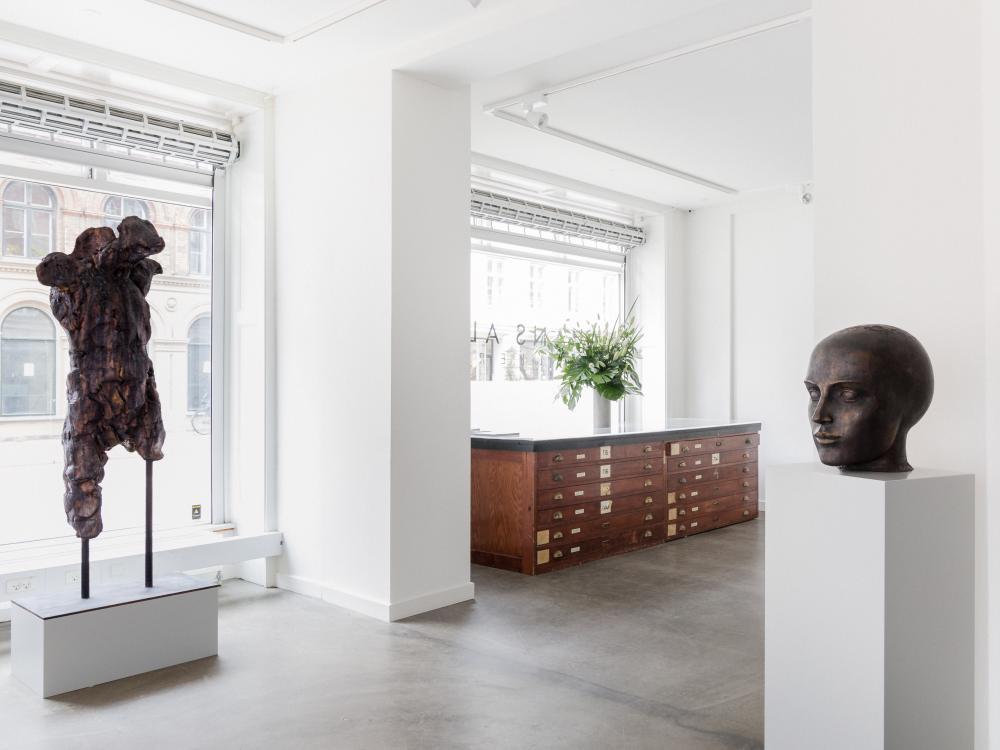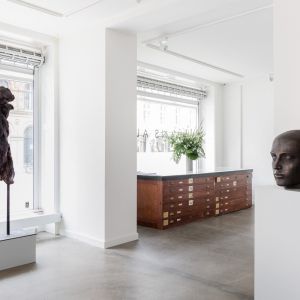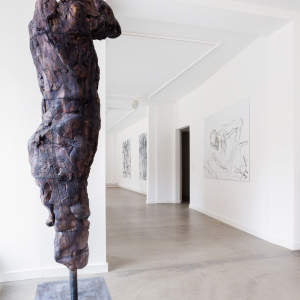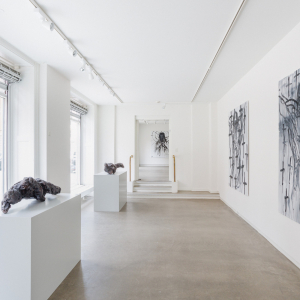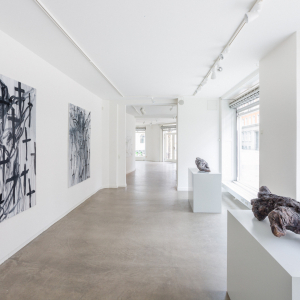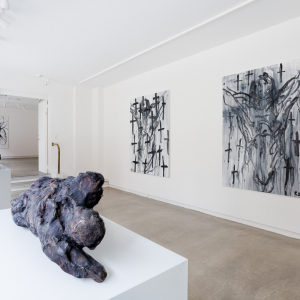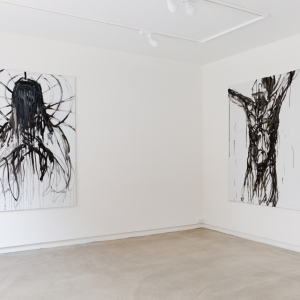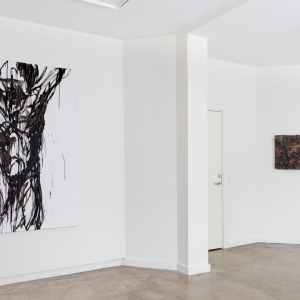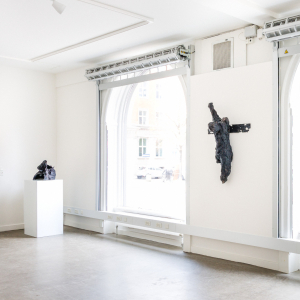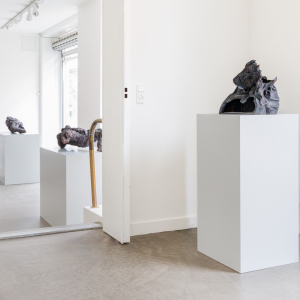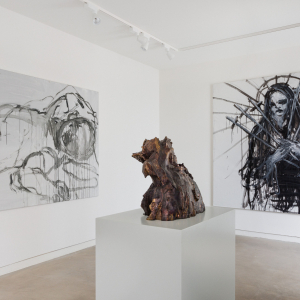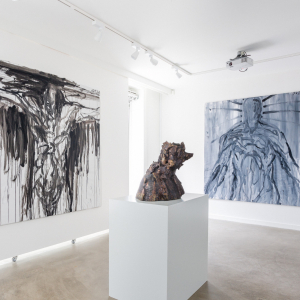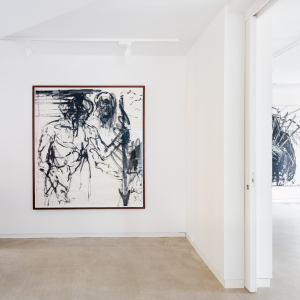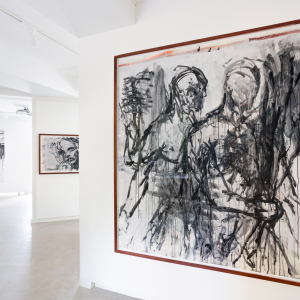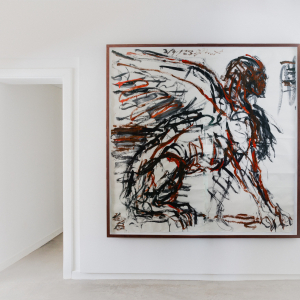Hans Alf Gallery is pleased to present Christian Lemmerz’ new exhibition "Works 22/23". Created over the past two years, the exhibition will fill the entire gallery with the versatile artist’s latest series of works on canvas and paper, bronze sculptures and reliefs.
“En route to the exhibition, Christian Lemmerz experienced being drawn towards the past. His mind became increasingly influenced by Catholicism. The mutilated figures he was modelling were easily modified into representations of Christ’s crucified body - and the violent visions he drew with black strokes on the white canvas wrapped themselves around the exact same motif over and over again. Occasionally, a mourning Madonna would appear, veiled or burdened with crosses, as well as a nude infant Jesus, lying on the ground in a foetal position, or with his mouth wide open, crying and gesturing.
Rooted in the great tradition of Christian art, the motifs thus have a retrospective character. This may not come as a surprise, given his extensive and contentious artistic career that has allowed him to develop a colossal pictorial capacity. His repertoire primarily comprises works from Western culture, and particularly the Italian Renaissance where prolific artists such as Michelangelo, Titian, and Tintoretto have made an impact. Through the use of passionate imagery, Lemmerz frequently engages in dialogue with their subjects, whether consciously or unconsciously, encapsulating the spirit of our era.
In 2023, Michelangelo has a prominent influence on both Lemmerz’s sculptures and paintings. The motifs may be traditional, with bronze casts or canvas paintings, but they are not necessarily retrospective. Lemmerz has modernised both motifs and techniques.
The use of Michelangelo as a reference is limited to sketches and works that the famous artist would not have retained. Michelangelo favoured working with white marble instead of bronze modelling. Additionally, some of Michelangelo’s sketches were used for fuel, resulting in only a limited number of them being preserved. As a consequence, only a small number of his most immediate statements have survived to present times.
Although it may appear illogical, for an artist like Lemmerz, who places a high value on traditions, this is also exceedingly stimulating.
The sculptures were modelled from a collection of uncommon and relatively diminutive clay or plaster models that were salvaged from Michelangelo’s own hand. The outcome of this artistic encounter through time has given rise to a sequence of exceedingly simple figures, either resting in agony or endeavouring to maintain their balance, in spite of their absent limbs and truncated heads.
According to Lemmerz, these are interpretations of figures such as Adam, Lazarus, Jesus or Mary Magdalene. Could it also be some of the many individuals who die daily on both sides of the front line in Ukraine? The latter proposition is not entirely implausible, given that in 2022, Lemmerz showcased a compact yet powerful exhibition that solely comprised enraged and helpless images depicting the Russian invasion and its resultant atrocities.
The recent paintings by him bear the same despondent nature, with all of them being executed in frenzied and forceful strokes. It appears that Lemmerz devoted his entire life to expressing his ideas and thoughts on the canvas freely before time runs out. One by one, he captured these visions expressively, figuratively, and narratively without any filters, always with a clear focus on the message he wants to convey.
The closest to an art historical definition of these painted depictions of human suffering is the genre known as Grafitti. This Italian term pertains to images and texts drawn or inscribed on walls and murals wherever people have gone. Grafitti is a popular genre, encompassing the oldest visual statements on human existence, known to us as the cave paintings. These cave paintings, such as those found in Lasceaux, Chauvet, and Altamira in southern France and Spain, are estimated to be around 40,000 years old. Remarkably, these ancient artworks are widely considered to be unparalleled in their quality and execution.
Graffiti has undergone a significant transformation since its birth in New York in the 1970s. Originally an underground phenomenon, it has now been adopted by the art establishment and become a fashion trend, with exhibitions in top museums such as Louisiana. This has resulted in the current version of graffiti becoming a style of its own, though rather curiously, it has faced limitations that have inhibited any significant evolution despite half a century of existence. The adaptation of the style by unskilled practitioners is apparent, and a comparison can be drawn with the salon painting that dominated the art world in the late 19th century.
It is important to note that Lemmerz’ new works do not feature the kind of fashionable graffiti commonly seen. For the author, the authenticity and continuity of the art form are crucial. The art has remained uninterrupted since the Lasceaux and Altamira periods, with inspiring examples on display in various locations, including the walls of Pompeii’s ruins and the cell walls of Tønder Arrest. These immediate statements demonstrate a vital nature, with anonymous individuals reaching out to others in the quest to be seen and heard. The language used is typically simple and primitive, yet still easy to read and therefore intellectually stimulating.
Something similar applies to Lemmerz’ violent interpretations of Christ’s crucifixion and Mary in mourning. Although they are neither simple nor primitive in their execution, they are easily recognisable and strike a chord - even if you’re not Catholic. They may be burdened by tradition, but Lemmerz has brought them into the present by interpreting them in a contemporary style. Like a drawing by Mette Dreyer - or a sketch by Michelangelo.
Michelangelo, that’s right! Because he also did graffiti. Probably often in the places where he worked with things. But the only thing we know for sure is that he did it in 1530.
It came to light in 1976 when some whitewashed walls were uncovered in a long, barrel-vaulted room at street level beneath the Sagrestia Nuova, the Medici family burial chapel in the church of San Lorenzo in Florence - a chapel that Michelangelo had both designed as an architect and created as a sculptor. But he also drew on the walls, re-portedly during a period in 1530 when his life was threatened and he hid in the barrel-vaulted room.
All the walls and the two window recesses down here turned out to be covered with magnificent graffiti, which Michelangelo drew with charcoal on chalk when ideas were pressing. Most of the drawings are life-size or larger, a far cry from the few intimate sketches on paper that can be found in museum storerooms.
Here, in the spacious barrel-vaulted chamber, the artist is portrayed in large-scale. One of the drawings depicts a colossal naked man leaping out of the wall - and another shows an equally naked man bending drastically forward and looking between his own legs at Michelangelo himself, who must have been amused by the sight, with a charcoal pencil in his hand.
The charcoal drawings are well-preserved and dynamic in their impulsive and vibrant lines. It is as though Michelangelo has just departed the room to ascend to the sacristy and resume sculpting. All temporal distance is eradicated, and he is revealed as both an artist and a human being, rather than just a legendary genius of the past.
Essentially, he speaks directly to us, including Lemmerz, who frequents this enchanting location during his visits to Florence. The conversation is entirely candid and unedited. The two artists are sustaining a close connection which exceeds both time and space. Their conversation is not nostalgic, but immediate.
Michelangelo allowed his figures to take shape on whitewashed walls, as thoughts in flight, as concepts materialising into existence in the present moment - and Lemmerz responds in the same vein, five hundred years later. His line and goal are similar, although the older artist drew it out with charcoal on the wall, the younger used acrylics on canvas. His line and goal are similar, although the older artist drew it out with charcoal on the wall, the younger used acrylics on canvas. Both artists had a focus on the existential. No hesitation - and no fuss.”
- Art historian Dr. Mikael Wivel, Copenhagen, 2023
About the artist:
Christian Lemmerz (born 1959 in Karlsruhe, Germany) lives and works in Copenhagen, Denmark and Pietrasanta, Italy. Lemmerz attended the Accademia di Belle Arti in Carrara, Italy, from 1978 to 1982 and the Royal Danish Academy of Fine Arts in Copenhagen from 1983 to 1988. His artistic practice revolves around profound existential questions. Throughout his career, he has expressed himself through a wide range of media, including drawing, painting, sculpture, installation, video art, virtual reality, theatre and performance. Lemmerz has exhibited extensively both in Denmark and internationally. His work is represented in numerous private collections, such as the Saatchi Collection in London, and major Danish art museums, including the National Gallery of Denmark, Horsens Art Museum and ARoS. In recognition of his artistic contributions, Lemmerz has received numerous awards, including the Ny Carlsberg Foundation Artist Grant in 2015, the Thorvaldsen Medal in 2009 and the Eckersberg Medal in 1998.
"Works 22/23" opens October 27 and will be on view through November 25.
